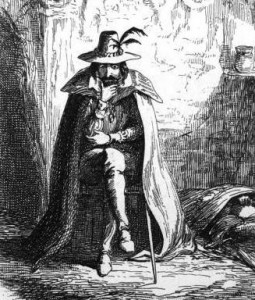The fifth of November,
The Gunpowder treason and plot;
I know of no reason
Why the Gunpowder treason
Should ever be forgot!
Guy Fawkes and his companions
Did the scheme contrive,
To blow the King and Parliament
All up alive.
… make the bells ring!
…God save the King!
The Protestant King James I of England had recently taken the throne in March 1603 after the death of Elizabeth I. There was hope that anti-Catholic laws would become less severe, but as of 5 November 1605, that had yet to happen.
Guy Fawkes was recruited in May 1604 by Thomas Wintour, cousin of Robert Catesby, to assist with the diabolical plot of blowing up the King, the Prince of Wales, and others at the next Opening of Parliament. The conspirators would then kidnap Prince Charles and Princess Elizabeth and return the country to the catholic fold.
Fawkes was an established mercenary, having been a distinguished member of the Spanish army. The first plan for the plot was to dig a tunnel underneath parliament. Catesby rented a house close to the Palace of Westminster so they could begin digging. This proved to be an exercise in futility, so, in March 1605, the party made use of their connections and rented a cellar beneath the House of Lords. Lord Monteagle, another party to the plot, received an alarming letter not ten days before the Opening of Parliament, showing that their plot had been foiled. Several members of the conspiracy then fled.
Guy Fawkes was in the rented cellar the night of 4 November into 5 November when the authorities came to inspect its contents. The gunpowder discovered, Guy Fawkes was quickly taken into custody. Though pressed to give up the names of his co-conspirators, Fawkes kept his silence. The rebels made a final press on 6 November and raided Warwick Castle. On 8 November, most of the rebels were finally apprehended; Wintour was shot in the shoulder and later died of his wounds. Catesby, along with others, were also shot dead. A few other conspirators were arrested on 12 November and 27 November, then taken to the Tower.
Several interrogations and trials later, the traitors were set to be executed on 30 January 1606. The bodies of Catesby and Wintour were dug up and decapitated. Some conspirators were dragged through the streets, then publicly hanged until they were half-dead, then castrated and disemboweled before being quartered. Guy Fawkes was hanged, drawn and quartered, as well. However, Fawkes, although weakened from torture, managed to jump down from the gallows and break his neck in the noose, thus preventing him from feeling the further agonies of being drawn and quartered.
Sadly, the Gunpowder treason and plot had the exact opposite effect on Parliament and King James I in that more restrictive anti-Catholic laws were passed in the summer of 1606. Remember, remember, the fifth of November!
You may also be interested in:
- Gunpowder Plot Places to Visit
- 5th November 1605 - The Gunpowder Plot
- Gunpowder 5/11: The Greatest Terror Plot Video
Heather R. Darsie lives in the United States with her family and three parrots. She works in the legal field, with a focus on children. She obtained a Bachelor of Arts degree in German Languages and Literature, then a Juris Doctorate in American jurisprudence, and studied abroad in Costa Rica and France. Heather has always loved history. She first became acquainted with Elizabeth I when she was in middle school and chose to write a book report about her. Since then, she has always held an interest in the Renaissance and its numerous enigmatic citizens, with particular focus on the history of England and Italy. She is currently working on a book on the heraldry of Tudor women and is also researching Anne of Cleves.
Sources and Suggested Reading
- Compilation. “The Fifth of November.” ca. 1870. http://www.potw.org/archive/potw405.html Retrieved 27 October 2015.
- Ford, David Nash. “The Gunpowder Plot: Overview.” http://www.britannia.com/history/kaboom.html Retrieved 27 October 2015.
- Northcote Parkinson, C. Gunpowder Treason and Plot. (Weidenfeld and Nicolson: 1976).
- Brice, Katherine. The Early Stuarts 1603–40. (Hodder Education: 1994).
- Fraser, Antonia. The Gunpowder Plot. (Phoenix: 1996, 1995).




Watching the fireworks from my window tonight it was easy to have fun, the events of 1605, the treatment of Catholics and the reaction to the plot seem so unconnected today. Yet, this was the greatest terror act the capital faced. Had Fawkes not been found, just before midnight on the eve of the 5th, the day Parliament was to open, had he not been questioned by the King, the gunpowder found, the next afternoon, Kaboom. James planned to take Prince Henry, his heir with him to open Parliament, the members, commons and lords and several petitioners would have been there. Some 13 or so Catholic Lords were present. All of them would be killed. The blast, experimental archaeology showed would destroy property for miles around, shatter windows, other people would be killed. Chaos would follow. The plot was also meant to kidnap the Princess Elizabeth and use her as a pawn in a new England, the Catholic Midlands were meant to rise as well and horseman stood by to encourage this. This was well planned, in the aim of destruction it would have succeeded. Whether the other elements of the plot were realistic is guesswork. It is actually scary just how close Catezby and his friends were to slaying the entire English government and crown.
But why did these men do this? Where they fanatical crazies? No, they were all well educated, all from well to do families, all fervant Catholics, all idealistic. Robert Catesby was a gentleman who had been imprisoned after the Essex revolt, he had property in Warwickshire, Sir Thomas Percy and Winter were connected by marriage and Percy was the brother of Northumberland. Digby was a gentleman who at first did not want anything of the plot but was sucked in and Guiudo Fawkes was a soldier of fortune, the explosives expert. He had Spanish contacts and access to black market gunpowder, lots of it. Catesby was a fanatic, the others not so much.
It seems also that the plotters tried to dig into Parliament but abandoned this. Catesby brought others in and they may have had a spy. Discord broke out, some wanted out, Winter for one, but Catesby insisted. They had all taken a sacred vow to do this and to give their lives. They carried on. The Secretary Robert Cecil may have been aware of the plot, may have allowed it to run its course. He is believed to have been told about it by the famous Monteagle Letter and ordered the search of the cellar below Westminster because of this. That is the story anyway.
Fawkes was tortured for days, his confession forced out, the names given and the plot blown wide open. In addition the others fled, were hunted down and some, Catesby included went out in a blaze of glory. Those who were not killed were tried and executed, being hung drawn and quartered, Fawkes the last to die. We remember Guy Fawkes, the guy with the gunpowder, we have forgotten the others. Over the months and years after the plot several other people were executed, many who were totally innocent, others placed in prison and Father Garrett escaped from the Tower, leaving his story, after three years in prison.
Why do this? James, it was hoped would be sympathetic to Catholicism, he would end the persecution, but he renagued on his promise, issued a declaration that said you can be Catholic and leave or conform. This group of head strong young men were disillusioned, unhappy and devout. James was a foreign King. He had a very Scottish court. He was not popular. England was officially Protestant, but with large areas where the old faith was practiced. It was still undergoing several changes. This group were idealistic, they had already been involved in a failed revolt, they were malcontents. They were fervant Catholics, although some were convinced converts. They recalled the martyrs under Elizabeth and were fired up. When James did not give them all they hoped for they were the perfect people to remove him. The Gunpowder Plot was genius and daring. It almost succeeded. However, it failed, hailing 300 years of persecution and prejudices that are still with us today. In many ways the sentiments felt by the young men who plotted to kill their King and his entire government seem alien to us now, but in our own lifetime we have witnessed horror and murder caused by suicide bombings, freedom fighters and extreme terror groups. The very concept of tolerance is challenged when we see journalists killed for a cartoon character, but we can never give up or go back to those times. We can only remember the 5th November and ensure our society never drives anyone to such a desperate act again.
Banditqueen, thank you very much for your thoughtful contribution!